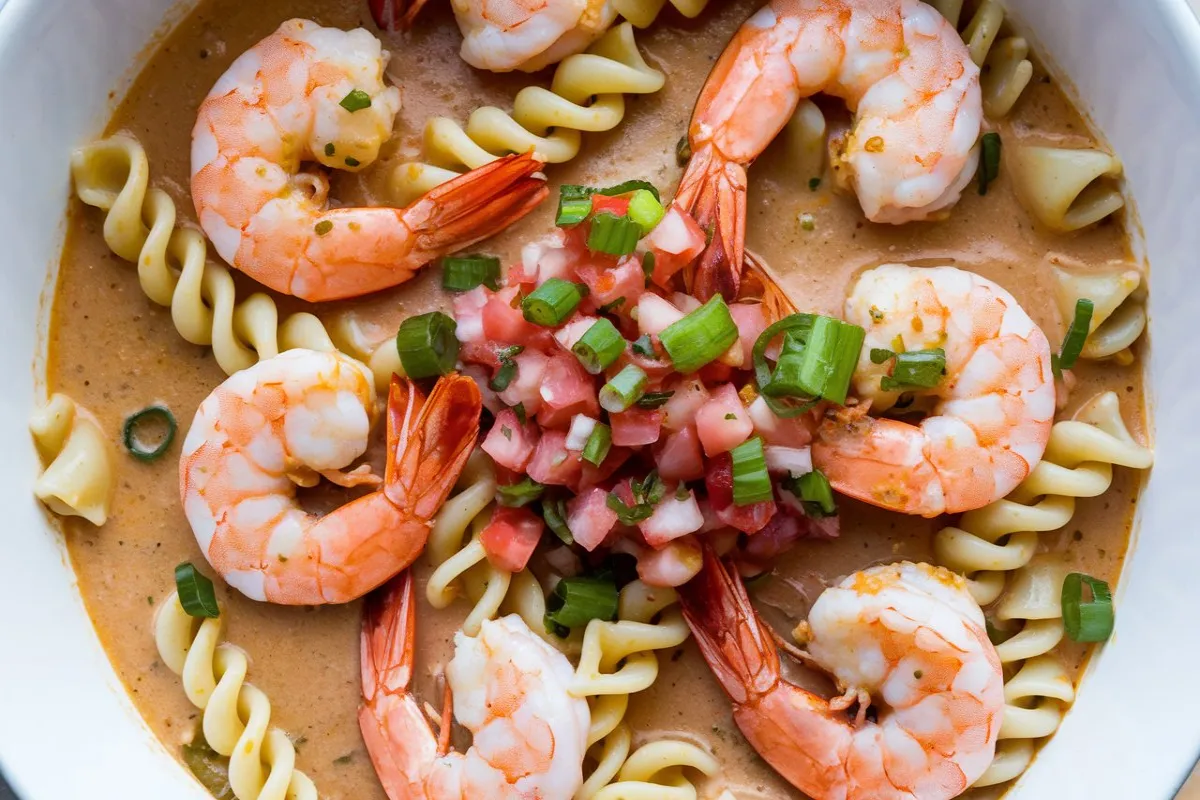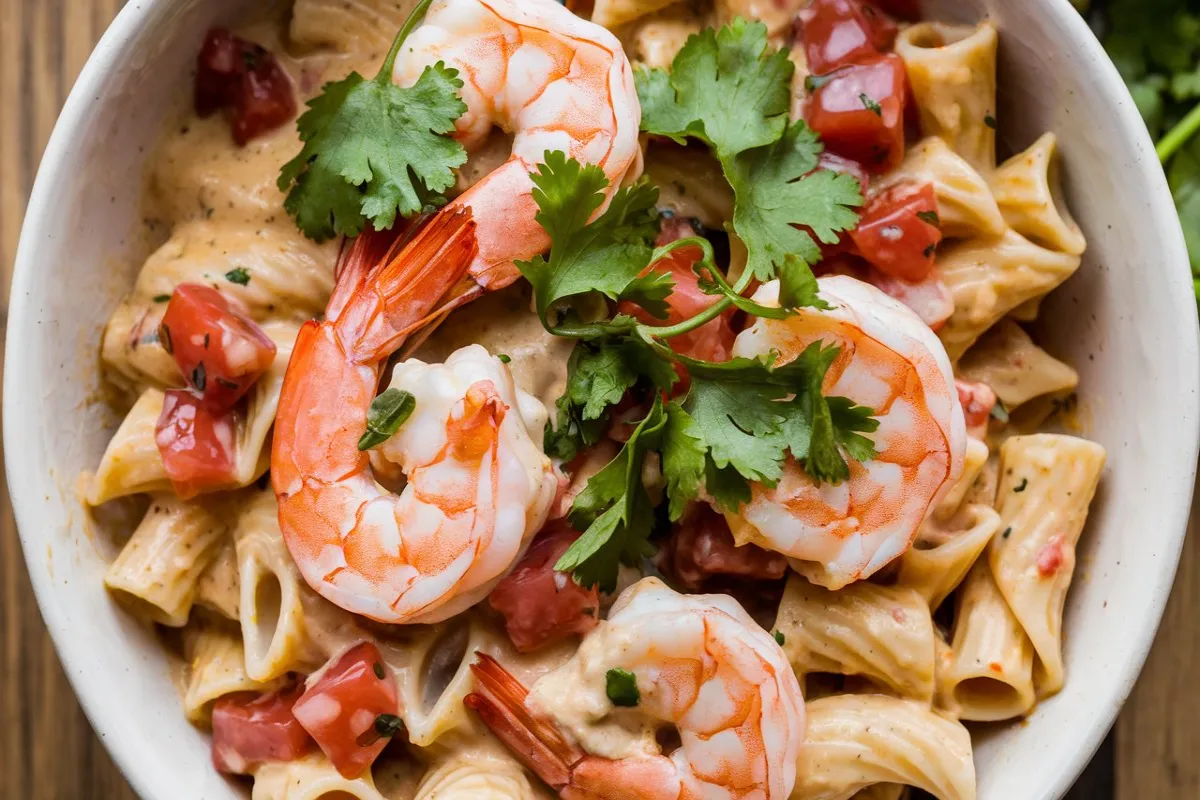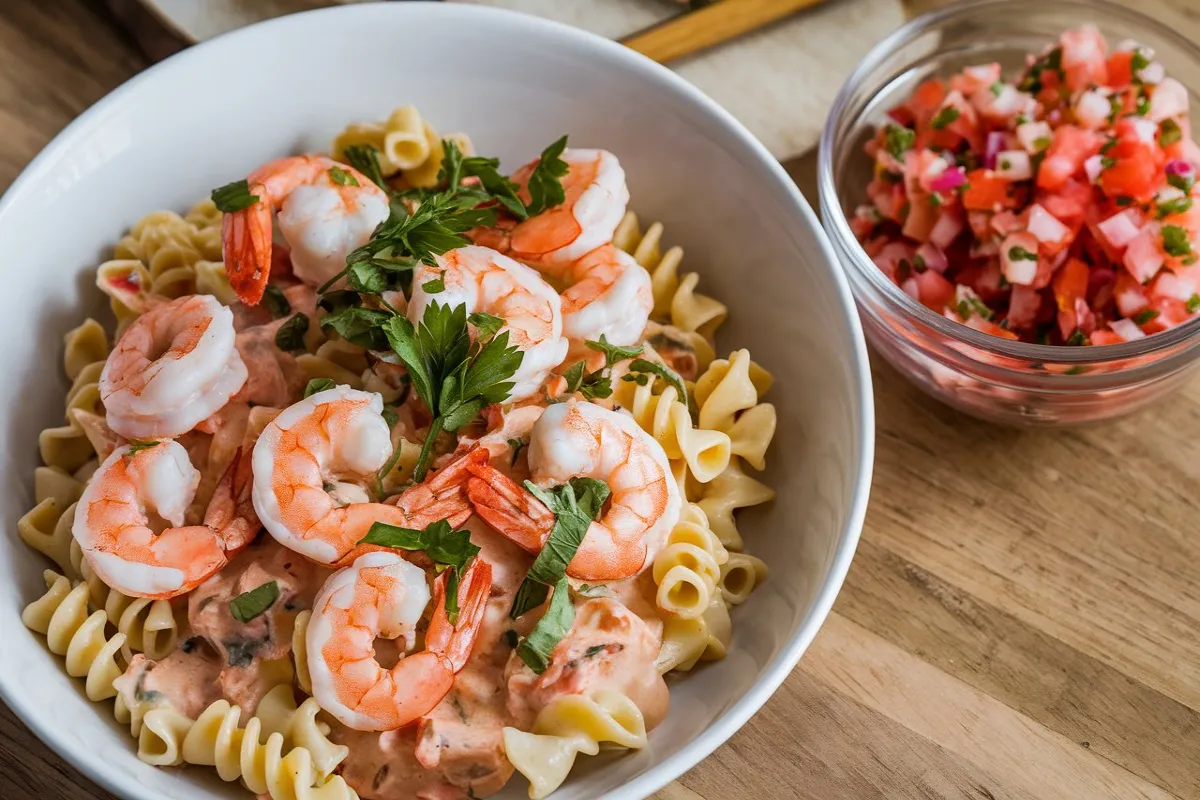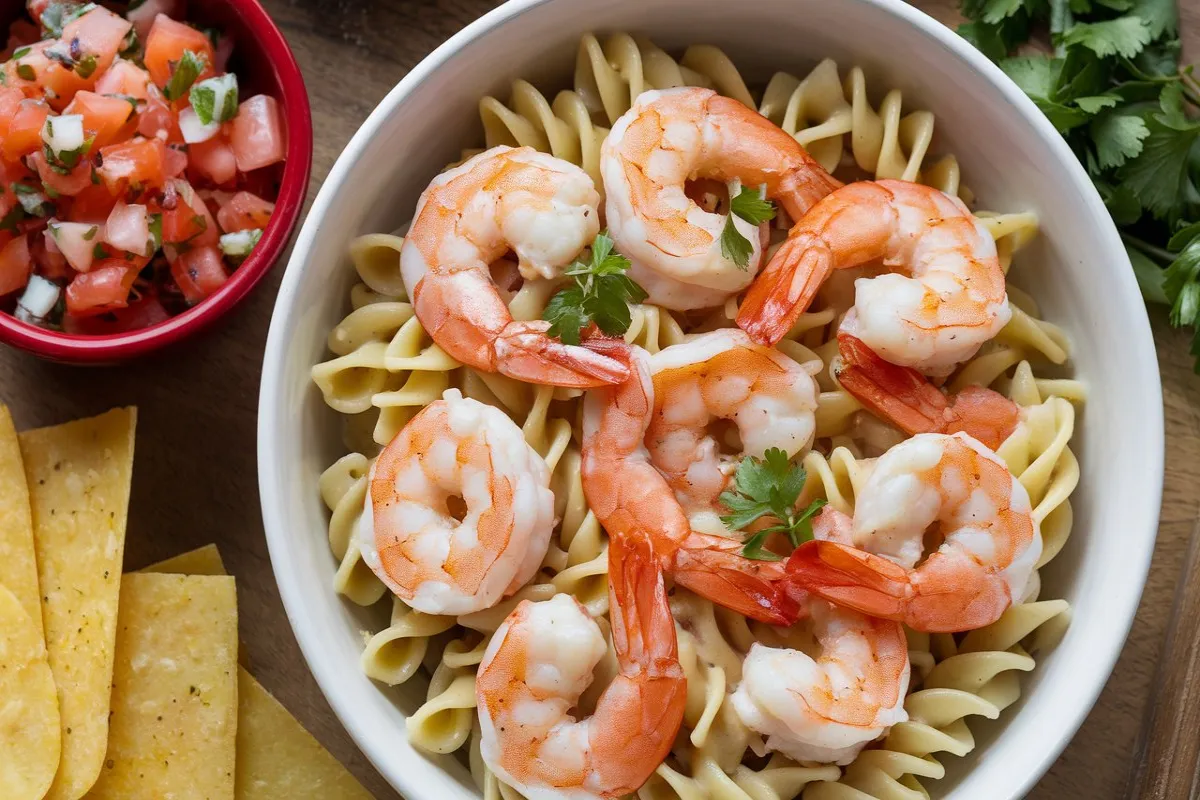Creamy shrimp and pasta recipes are beloved for their rich, satisfying flavors and comforting textures. But when you add the fresh, vibrant kick of pico de gallo to the mix, you elevate the dish to a whole new level. This fusion of Italian and Mexican cuisines brings together the creamy decadence of shrimp pasta with the tangy, zesty freshness of pico de gallo, resulting in a dish that is both unique and versatile. Whether you’re a fan of traditional pasta dishes or looking to try something new, this creamy shrimp and pasta recipe with pico de gallo is sure to delight your taste buds.
In this guide, we’ll explore everything you need to know to create the perfect creamy shrimp and pasta recipe with pico de gallo. From understanding the origins of these ingredients to following a step-by-step recipe, you’ll be fully equipped to impress your family and friends with this flavorful dish. Discover the health benefits of shrimp and learn how to choose the best shrimp for your recipe as we dive into this culinary journey centered around the creamy shrimp and pasta recipe with pico de gallo.
History and Origins of Creamy Pasta Dishes and Pico de Gallo
To truly appreciate this fusion dish, it’s helpful to understand the history and origins of its key components: creamy pasta and pico de gallo.
Creamy Pasta Dishes
Creamy pasta dishes have their roots in Italian cuisine, where rich sauces like Alfredo and carbonara have long been staples. These sauces, often made with butter, cream, and cheese, create a luxurious base that perfectly complements a wide variety of ingredients, from vegetables to seafood. Over time, creamy pasta recipes have evolved and spread across the globe, with each culture adding its unique twist. In American cuisine, shrimp pasta has become a popular variation, combining the rich flavors of cream with the delicate sweetness of shrimp.
Pico de Gallo
Pico de gallo, also known as salsa fresca, is a traditional Mexican condiment made from fresh tomatoes, onions, cilantro, jalapeños, and lime juice. This vibrant salsa is known for its bright, tangy flavor and its versatility as a topping for tacos, grilled meats, and more. The name “pico de gallo” translates to “rooster’s beak,” possibly referring to the way it was originally eaten by pinching it between the thumb and forefinger. Combining pico de gallo with a creamy pasta dish might seem unconventional, but the contrast of textures and flavors creates a harmonious and delicious fusion.
By blending these two culinary traditions, the creamy shrimp and pasta recipe with pico de gallo offers a delightful balance of richness and freshness that is sure to satisfy.
Ingredients for Creamy Shrimp and Pasta with Pico de Gallo
Creating a creamy shrimp and pasta recipe with pico de gallo requires a selection of fresh, high-quality ingredients. Each component plays a crucial role in achieving the perfect balance of flavors and textures.
Main Ingredients
- Shrimp: Fresh or frozen shrimp can be used, but fresh shrimp will generally provide the best flavor and texture. Learn how to choose the best shrimp to ensure your dish turns out perfectly.
- Pasta: Choose a pasta that pairs well with creamy sauces, such as fettuccine, linguine, or penne.
- Cream: Heavy cream is the traditional choice for a rich, decadent sauce, but you can also use half-and-half or a dairy-free alternative if desired.
Pico de Gallo Ingredients
- Tomatoes: Opt for ripe, juicy tomatoes, such as Roma or vine-ripened varieties, which offer the best flavor for pico de gallo.
- Onions and Cilantro: Fresh onions and cilantro are essential for adding flavor and freshness to the salsa.
- Jalapeños: If you like a bit of heat, include jalapeños in your pico de gallo. Adjust the amount to your spice preference.
Substitutions for Dietary Needs
- Gluten-Free Pasta: If you or your guests are gluten-sensitive, there are many excellent gluten-free pasta options available. Check out this guide to gluten-free pasta to find the best brands.
- Dairy-Free Cream: For those avoiding dairy, coconut milk or cashew cream can be used as a substitute for heavy cream.
How to Make Creamy Shrimp and Pasta with Pico de Gallo: Step-by-Step Instructions
Now that you have your ingredients ready, let’s walk through the steps to create this delicious dish.
Preparation
- Prepping the Shrimp: Begin by peeling and deveining the shrimp. If you’re using frozen shrimp, make sure they are fully thawed before cooking. Marinate the shrimp with a little salt, pepper, and garlic powder for extra flavor.
- Cooking the Pasta: Bring a large pot of salted water to a boil and cook the pasta according to the package instructions until it’s al dente. Drain the pasta, reserving a cup of pasta water for later use.
- Making the Pico de Gallo: While the pasta cooks, prepare the pico de gallo. Dice the tomatoes, onions, and jalapeños, then mix them with chopped cilantro and lime juice. Season with salt to taste and set aside.
Cooking the Shrimp
- Sautéing the Shrimp: Heat a tablespoon of olive oil in a large skillet over medium heat. Add the shrimp in a single layer and cook for 2-3 minutes on each side until they turn pink and opaque. Be careful not to overcook the shrimp, as they can become rubbery.
- Removing the Shrimp: Once the shrimp are cooked, remove them from the skillet and set aside.
Making the Creamy Sauce
- Building the Sauce: In the same skillet used for the shrimp, add a bit more olive oil if needed and sauté minced garlic until fragrant. Pour in the heavy cream and bring it to a gentle simmer. Stir in grated Parmesan cheese, if using, and season with salt and pepper.
- Incorporating the Shrimp: Return the shrimp to the skillet, stirring to coat them in the creamy sauce. If the sauce is too thick, add a little reserved pasta water to reach the desired consistency.
Combining the Pasta, Shrimp, and Sauce
- Mixing the Pasta: Add the cooked pasta to the skillet with the shrimp and sauce. Toss everything together until the pasta is well-coated and the ingredients are evenly distributed.
- Adjusting the Seasoning: Taste the pasta and adjust the seasoning as needed, adding more salt, pepper, or Parmesan if desired.
Adding Pico de Gallo and Serving
- Topping with Pico de Gallo: Just before serving, top the creamy shrimp pasta with a generous amount of pico de gallo. The fresh salsa adds a burst of flavor and a contrast to the rich creaminess of the pasta.
- Garnishing and Serving: Garnish with extra cilantro or lime wedges if desired. Serve the pasta immediately, while it’s still hot and the flavors are at their peak.
Variations of Creamy Shrimp and Pasta with Pico de Gallo
This dish is incredibly versatile, allowing you to make several variations to suit your taste preferences or dietary needs.
Spicy Shrimp and Pasta with Pico de Gallo
- Extra Heat: If you enjoy spicy food, consider adding more jalapeños to the pico de gallo or incorporating a dash of hot sauce into the creamy sauce. You can also sprinkle red pepper flakes over the finished dish for an added kick.
Cheesy Shrimp and Pasta with Pico de Gallo
- Incorporating Cheese: For a richer, more indulgent dish, stir in shredded mozzarella or cheddar cheese into the creamy sauce. The melted cheese will add an extra layer of flavor and creaminess to the pasta.
Vegan or Vegetarian Variations
- Substituting Shrimp: If you prefer a vegetarian version, replace the shrimp with tofu, mushrooms, or even chickpeas. Use a dairy-free cream alternative and vegan cheese to keep the dish plant-based.
- Vegetarian Pasta: You can also make this dish completely vegetarian by omitting the shrimp and adding more vegetables like bell peppers, spinach, or zucchini.
Low-Calorie or Low-Carb Options
- Using Zoodles: For a low-carb alternative, replace the pasta with zucchini noodles (zoodles). These spiralized vegetables offer a lighter version of the dish while still pairing well with the creamy sauce and pico de gallo.
- Reducing Cream: Use a lighter dairy alternative or reduce the amount of cream to lower the calorie content. You can also use Greek yogurt as a substitute for a tangy, lower-fat option.
Tips for Perfecting Your Creamy Shrimp and Pasta with Pico de Gallo
Creating the perfect creamy shrimp and pasta with pico de gallo involves attention to detail. Here are some tips to ensure your dish turns out just right.
Choosing the Right Shrimp
Fresh vs. Frozen: While fresh shrimp often provide the best flavor and texture, high-quality frozen shrimp can be just as good and are more convenient. When choosing shrimp, look for ones that are plump, firm, and have a mild, briny smell. If using frozen shrimp, make sure to thaw them properly by placing them in the refrigerator overnight or running them under cold water before cooking.
Achieving the Perfect Creamy Sauce
- Balancing Thickness and Flavor: The key to a great creamy sauce is achieving the right consistency—not too thick, not too thin. If your sauce is too thick, you can thin it out by adding a bit of reserved pasta water, which also helps to bind the sauce to the pasta. If the sauce is too thin, let it simmer a bit longer to reduce and thicken. Taste the sauce as you go and adjust the seasoning to your liking, adding more salt, pepper, or cheese as needed.
- Avoiding Curdling or Separation: To prevent the sauce from curdling or separating, make sure to cook it over low to medium heat and avoid boiling it. Adding the cream gradually and stirring constantly can help maintain a smooth, creamy texture.
Balancing the Flavors with Pico de Gallo
- Flavor Harmony: The fresh, tangy flavors of pico de gallo are a perfect counterbalance to the rich, creamy sauce. To achieve the right balance, ensure that your pico de gallo is well-seasoned with lime juice and salt. The acidity of the lime juice cuts through the richness of the cream, while the fresh tomatoes, onions, and cilantro add brightness and a bit of crunch to the dish.
- Adjusting Spice Levels: If you prefer a milder dish, reduce the amount of jalapeño in the pico de gallo. Conversely, if you like it spicier, you can add extra jalapeños or even a dash of hot sauce to the pico de gallo or the creamy sauce.
Health Benefits of Creamy Shrimp and Pasta with Pico de Gallo
This dish is not only delicious but also offers some nutritional benefits, especially when made with fresh, high-quality ingredients.
Nutritional Benefits of Shrimp and Tomatoes
- High in Protein: Shrimp is an excellent source of lean protein, which is essential for muscle growth and repair. It’s also low in calories and fat, making it a healthy choice for those looking to maintain or lose weight.
- Rich in Antioxidants: Tomatoes, a key ingredient in pico de gallo, are rich in lycopene, an antioxidant linked to reduced risks of heart disease and certain cancers. They also provide Vitamin C, which supports immune health, and potassium, which helps regulate blood pressure.
Lightened-Up Variations for Health-Conscious Eaters
- Using Lower-Fat Cream: To reduce the calorie content of this dish, you can substitute heavy cream with half-and-half or a light cream alternative. Greek yogurt is another option that adds creaminess with less fat.
- Whole Wheat or Gluten-Free Pasta: Whole wheat pasta offers more fiber than regular pasta, making it a healthier choice. If you’re gluten-sensitive, opt for a high-quality gluten-free pasta to enjoy this dish without any discomfort.
Gluten-Free and Dairy-Free Alternatives
- Gluten-Free Options: As mentioned earlier, there are many gluten-free pasta options available that work well in this recipe. Check out this guide to gluten-free pasta to find the best brands.
- Dairy-Free Cream: Coconut milk, cashew cream, or almond milk can replace heavy cream for those who are lactose intolerant or following a dairy-free diet. Just be sure to choose an unsweetened variety to avoid altering the flavor of the dish.
Serving Suggestions for Creamy Shrimp and Pasta with Pico de Gallo
Pairing this dish with complementary sides and paying attention to presentation can enhance the dining experience.
Pairing Shrimp and Pasta with Side Dishes
- Salad Options: A light salad pairs wonderfully with the richness of this dish. Consider a simple Caesar salad with crisp romaine, Parmesan, and croutons, or a fresh garden salad with a lemon vinaigrette. The acidity in the dressing will help balance the creaminess of the pasta.
- Bread Options: Serve the pasta with a side of garlic bread or a crusty baguette. The bread is perfect for soaking up any extra creamy sauce, making sure nothing goes to waste.
Presentation and Plating Tips
- Garnishing with Fresh Herbs: Garnish the dish with freshly chopped cilantro or parsley to add a pop of color and a burst of fresh flavor. A few lime wedges on the side can also enhance the presentation and allow diners to add a bit more acidity if desired.
- Creative Plating Ideas: Serve the pasta in shallow bowls to keep the sauce contained and create a visually appealing presentation. For an extra touch of elegance, drizzle a little extra pico de gallo on top and sprinkle with grated Parmesan or crumbled feta.
Storing and Reheating Creamy Shrimp and Pasta with Pico de Gallo
If you have leftovers, storing and reheating them properly will ensure that the dish remains delicious the next day.
How to Store Leftovers
- In the Fridge: Store any leftover creamy shrimp and pasta with pico de gallo in an airtight container in the refrigerator. It should keep well for up to 3 days. To maintain freshness, keep the pico de gallo separate from the pasta if possible and add it just before reheating and serving.
- In the Freezer: While this dish is best enjoyed fresh, it can be frozen if needed. Place the cooled pasta in a freezer-safe container, leaving a little space at the top to allow for expansion. It will keep in the freezer for up to 2 months. For best results, freeze the pasta without the pico de gallo and make a fresh batch of salsa when you’re ready to serve.
Reheating Pasta without Losing Creaminess
- Stovetop Method: Reheat the pasta in a skillet over medium-low heat. Add a splash of milk, cream, or water to help loosen the sauce and prevent it from drying out. Stir frequently until the pasta is heated through and the sauce is smooth and creamy.
- Microwave Method: If you’re short on time, you can reheat the pasta in the microwave. Place the pasta in a microwave-safe dish, cover it loosely with a lid or microwave-safe wrap, and heat on medium power for 1-2 minutes. Stir halfway through and add a splash of liquid if needed to keep the sauce from drying out.
Freezing Creamy Shrimp and Pasta
- Freezing Tips: If you decide to freeze this dish, do so without the pico de gallo. This will prevent the salsa from becoming watery or mushy when thawed. When ready to eat, thaw the pasta in the refrigerator overnight and reheat using one of the methods above. Prepare a fresh batch of pico de gallo and add it just before serving for the best texture and flavor.
Frequently Asked Questions (FAQs)
Can I use frozen shrimp for this recipe?
Yes, you can absolutely use frozen shrimp for this recipe. Just make sure to thaw them properly before cooking. The best way to thaw shrimp is by placing them in the refrigerator overnight. If you’re short on time, you can also thaw them quickly by placing the shrimp in a colander and running cold water over them until thawed.
What type of pasta works best with creamy shrimp dishes?
Fettuccine, linguine, and penne are excellent choices for creamy shrimp dishes. These types of pasta hold up well to rich, thick sauces and allow the sauce to cling to each strand or piece, ensuring every bite is flavorful. If you prefer a lighter option, angel hair pasta can also work, but be careful not to overcook it as it is more delicate.
How do I make sure the shrimp doesn’t get overcooked?
To prevent shrimp from overcooking, it’s important to cook them just until they turn pink and opaque. This usually takes about 2-3 minutes per side, depending on the size of the shrimp. Overcooked shrimp can become tough and rubbery, so keep a close eye on them and remove them from the heat as soon as they’re done.
Is this dish spicy? How can I adjust the spice level?
The spice level of this dish largely depends on the amount of jalapeños you use in the pico de gallo. If you prefer a milder flavor, use less jalapeño or remove the seeds and membranes, which contain most of the heat. For a spicier dish, add extra jalapeños or include a dash of hot sauce in the creamy sauce.
Can I make this recipe ahead of time?
Yes, you can make parts of this recipe ahead of time. The pico de gallo can be prepared a day in advance and stored in the refrigerator. You can also cook the shrimp and make the creamy sauce ahead of time, then store them separately in the fridge. When you’re ready to serve, cook the pasta, reheat the shrimp and sauce, and assemble the dish.
Conclusion
Creamy shrimp and pasta recipes with pico de gallo combine the best of Italian and Mexican cuisines to create a dish that is both comforting and full of vibrant flavors. These creamy shrimp and pasta recipes with pico de gallo are perfect for any occasion, whether you’re looking for a quick weeknight dinner or an impressive dish to serve guests. The fusion of creamy pasta with the fresh, zesty pico de gallo makes these creamy shrimp and pasta recipes with pico de gallo a unique and delicious option that you’ll want to make again and again. With creamy shrimp and pasta recipes with pico de gallo, you can easily enjoy a meal that’s both satisfying and exciting.




